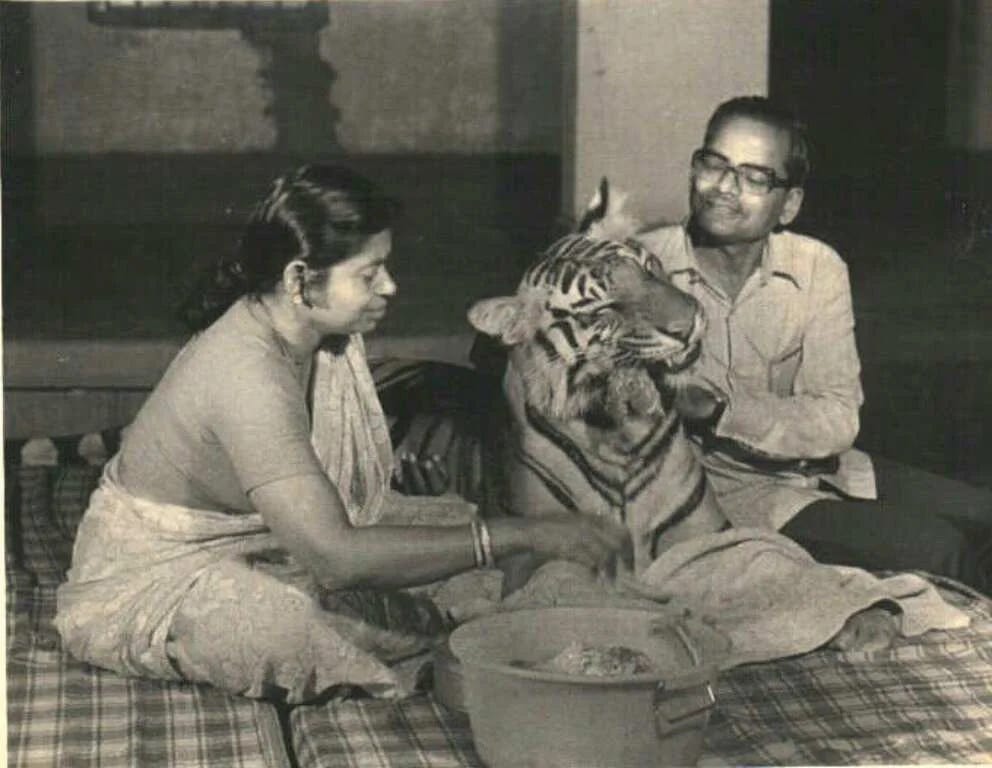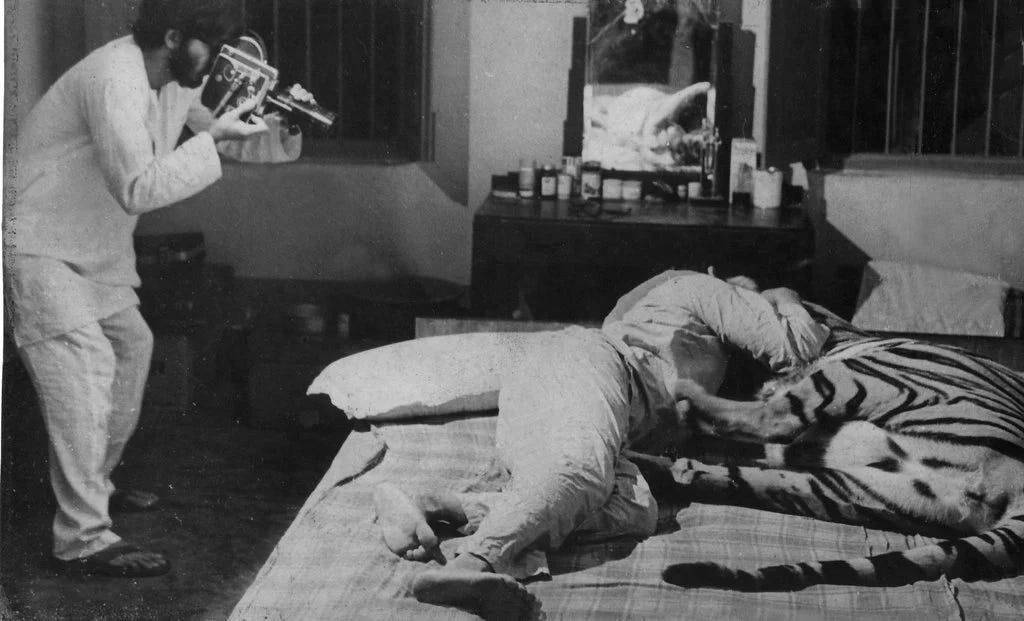India's wildlife officer who cared for a cub like his own child
The real story of an unlikely bond of father and daughter
Earlier this week, the United Nations World Wildlife Day (WWD) was celebrated on March 3. The idea behind earmarking a day to celebrate wildlife is, of course, so that people like me can effortlessly pick a theme and churn out their weekly posts for the Lighter Side. There’s also that reason that earmarking days like this can remind adults of the unique roles and contributions of wildlife to humanity. Children, bless their unjaded souls, don’t need these reminders. They’re the ones who actually stop to watch a caterpillar crawl up a branch or smile with glee when they see flowers swaying in the wind. Meanwhile, adults, who have mastered the uncanny ability to swoop in behind the children and hurry them kids along, can often be heard saying “Stop staring at that butterfly, Timmy! You have a math test to fail!” After all, caterpillars and flowers have no place in the life of an adult. Who has time for nature when there’s a never-ending to-do list devouring every inch of their mindspace?
But wait—there’s hope! A year and a half ago, I wrote about an adult who cared enormously about wildlife. This man, Saroj Raj Choudhury, and his wife, Nalini, took in creatures, cared for them as if they were their own children, proving that not all adults have sold their souls to the cult of productivity.
So, this week, in honor of Wildlife Day, do yourself a favor: pause for a nanosecond on your way to your car or bus or bicycle. Look at a flower. Watch a caterpillar. Count the stars at night. Pretend, just for a moment, that you’re not late for something. Happy Wildlife Day—I hope you enjoy re-reading this story of Saroj Raj Choudhury. And THEN I am sure you have your to-do list to get back to!
When I began researching about a forest officer called Saroj Raj Choudhury, here is what I found.
Saroj Raj Choudhury was an officer with the Indian Forest Services during the 1970s. He is famous for many acts of heroism in saving Indian forests and its wildlife. What he is particularly known for, is the true story of how he saved a tigress cub and how she became a part of his household.
I imagined that Saroj Raj was a huge well-built man, with a handlebar moustache and a rifle strapped to his shoulders. Google threw up a picture of this man. I could not have been more wrong. He had a round face, ever-smiling, and looked to me like he walked with a gentle gait. I also discovered that carrying guns inside Indian forests is permitted only under exceptional circumstances. Forest rangers in India are not allowed to walk around with a gun - nobody wants to fire a bullet into an animal, even by accident. Instead, they are permitted to carry tranquilizer guns.
Onto our story of a tigress and her unusual family
It was a cold evening in October, 1974. A few forest dwellers living in the Similipal forests of Odisha (a state located in eastern India) were returning home. On their way back, they found a seven-week old tiger cub near the river Khairi. The mother tigress was nowhere to be found. They knew that if they left this frail and weak cub without someone to protect it, she would not last too long in the forest. So they did the best thing they could think of - they carried the cub to the house of the field director of the Similipal forest. This was a man named Saroj Raj Choudhury.
With open arms, Saroj Raj Choudhury took the little cub into his home and fed her meat with his own hands. His wife, Nihar Nalini Swain, was no less caring. In no time, the tigress cub became a great friend of the couple. The cub roamed freely in their bungalow, jumping on to beds and chairs exactly as a pup or a kitten would do. Now that Saroj and Nalini had a pet scampering around, they had to give it a name. They decided to call the cub ‘Khairi’, after the river in the forest where she had been found.

Khairi was playful and gained strength rapidly. While she was growing huge and massive, she still loved to snuggle into the bed next to her ‘parents’, and fall asleep with her paws and tail spread across the length of the bed (imagine her tail rubbing against your nose while you are asleep!).

Khairi was not the only wild creature growing up in their home. Saroj Raj had rescued a blind hyena, a bear cub and a deer - who were all growing up together in the courtyard, along with Khairi. While they all had the freedom to run around and play together, they never needed to hunt, since the couple fed them their meals regularly. And so came together a most unlikely group of friends, playing together, completely oblivious to the relationship that their wilder kin shared in the wilderness.
At one point, the couple thought it was time to let Khairi out into the forest (they now had hardly any space left to sleep on the bed!). Also, they wanted her to live the natural life of a tigress.
So one fine morning, Saroj and Nalini opened the gates of their courtyard. Sure enough, Khairi scampered out into the wilderness of the forest.
By evening, the couple were already missing Khairi terribly, and wondering what she was up to. Had she met her kin? Was she learning to hunt? They didn’t have to wait too long. At midnight, Saroj Raj was woken up by loud roars from the courtyard gate. Khairi was back and asking her ‘family’ to let her in. Unwilling to be rude to her, Saroj Raj opened the door and she bounded onto him and gave him a loving hug with a gentle swipe of her paw. She was careful to never hurt anyone, for she did know her strength and how sharp her paws and teeth were. Khairi insisted on snuggling next to Nalini and finally fell sleep. Khairi was not keen on leaving her ‘loving home with her foster parents and many animal friends’. This became her permanent home.
One day, a good friend of Saroj Raj, M.K. Ranjitsinh (the first director of Project Tiger in India), was visiting them. He was sleeping in the guest room, when Khairi came sauntering into his room. Khairi decided that sunrise was about the time when everyone ought to be woken up (tigers can be weirdos too). So she used her tail and went tapping M.K.Ranjitsinh on his forehead to wake him up. He wanted to snooze in a little bit more and pulled his blanket to cover his face, and asked Khairi to go out for sometime. Khairi was not going to have any of it. She wanted to play with her new friend. So she decided to yank the blankets away from him, and used her teeth gently and let the blankets slide off him. He remained fast asleep on the bed and did not show any signs of getting up. Khairi decided to give one more go at waking him up and jumped on him, hoping that the extra 200 kg on him would do the trick (duh?). M.K.Ranjitsinh most unwillingly got up (after Khairi got off him, of course) and indulged her with a hug and some play-time. What was most remarkable about Khairi was that she knew the exact pressure with which to pull a blanket (and not tear it), when and how to jump on a human (without tearing their flesh or break their bones).
Saroj Raj Choudhury and Nalini Swain continued to live in their big bungalow in the forest, with their assortment of animal family, showering them all with love and affection. Saroj Raj, while an ardent animal lover, also took this opportunity to conduct field research. He kept a careful log of Khairi’s activities, what she ate, how she reacted to different foods (where else was a human going to plan a tigress’ diet), how her skin looked (who else was going to get to stroke a tigress to sleep), her mood swings and reactions to stimuli (who else was going to watch a tigress run around and play in a courtyard). This log or journal of Saroj Raj has remained of huge help to many wildlife researchers worldwide.
One evening, when Khairi was playing with the deer, she accidentally hurt the deer, thus killing it. Saroj Raj dug a grave for the deer and buried it. In attendance for this funeral were the forest rangers and the entire animal family (including the hyena, the bear and Khairi). After the funeral, when everyone else went their way, Khairi sat by the grave for three days and nights, without touching a drop of water or a morsel of food . Perhaps she felt guilty, perhaps she missed her friend - we’ll never know what went through her head in those three days.
Still sad after the deer’s death, a few weeks later, Khairi was running in the forest just outside the courtyard. She did not notice a rabid dog running towards her and was bitten by the dog (which carried a disease called rabies). Rabies is a deadly disease, and in 1981, there was no cure. The disease could spread from an infected creature to humans and animals around as well. As Khairi’s condition rapidly deteriorated that day, Nalini was left with no choice but to let Khairi die an early death, as painlessly as possible. Unfortunately, Saroj Raj was in Delhi that day, and could not come home in time to bid his ‘daughter’ good-bye.
Shortly after Khairi’s death, Saroj Raj Choudhury himself passed away. His friends and wife believe that he never really came to terms with Khairi’s sudden death.
Khairi and Saroj Raj Choudhury’s legendary bond is one of the stories I have discussed as part of ‘What’s New Today’ podcast series on wildlife. If you love more such stories, click on the button below to listen to the ‘Wildlife Series.
Whenever I read ‘The Jungle Book’ or ‘Tarzan’, I do know in my head that these are stories made up by their authors. I don’t start thinking that there really is a human child being cared for by a wolf in a jungle nearby. I hardly dare believe that a little boy sitting on a bear’s stomach can be heard singing ‘Bare Necessities’, nor do I imagine him swimming happily near crocodiles. But, what is extraordinary about Khairi’s story is that every bit of it is real. Her life in a bungalow next to a forest, cared for and loved by a family, roaming and running with her friends - bears, hyenas, deers and even crocodiles - all of these are carefully documented with pictures and testimonies of many people.
P.S: Nalini Swain passed away recently in an old age home in Cuttack, Orissa. She continued to cherish memories of her life with Khairi and Saroj Raj Choudhury, till her end.
You might like to read these stories on wildlife, published earlier on the Lighter Side
Elephants give each other names just like humans do - a research finds
Dogs rescue people in earthquakes in Taiwan
Panda bears are a symbol of friendship between countries
References related to this story of Khairi
Story of Khairi on Youtube in Hindi
Interview with Dr M K Ranjitsinh, Chairman of the Wildlife Trust of India
Obituary on the death of Nihar Nalini Swain on the Hindustan Times



